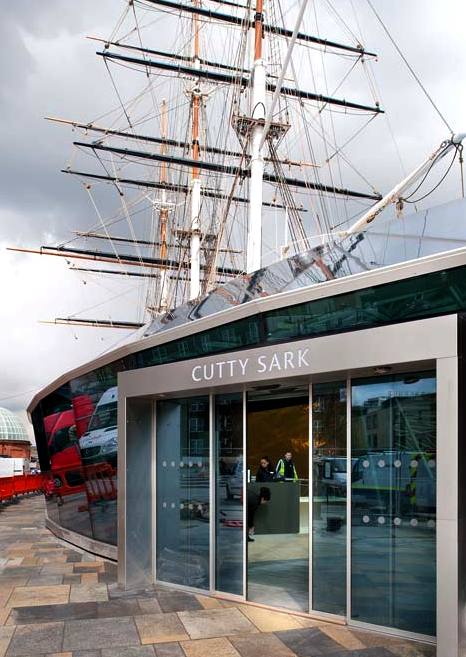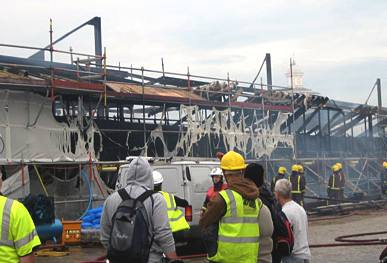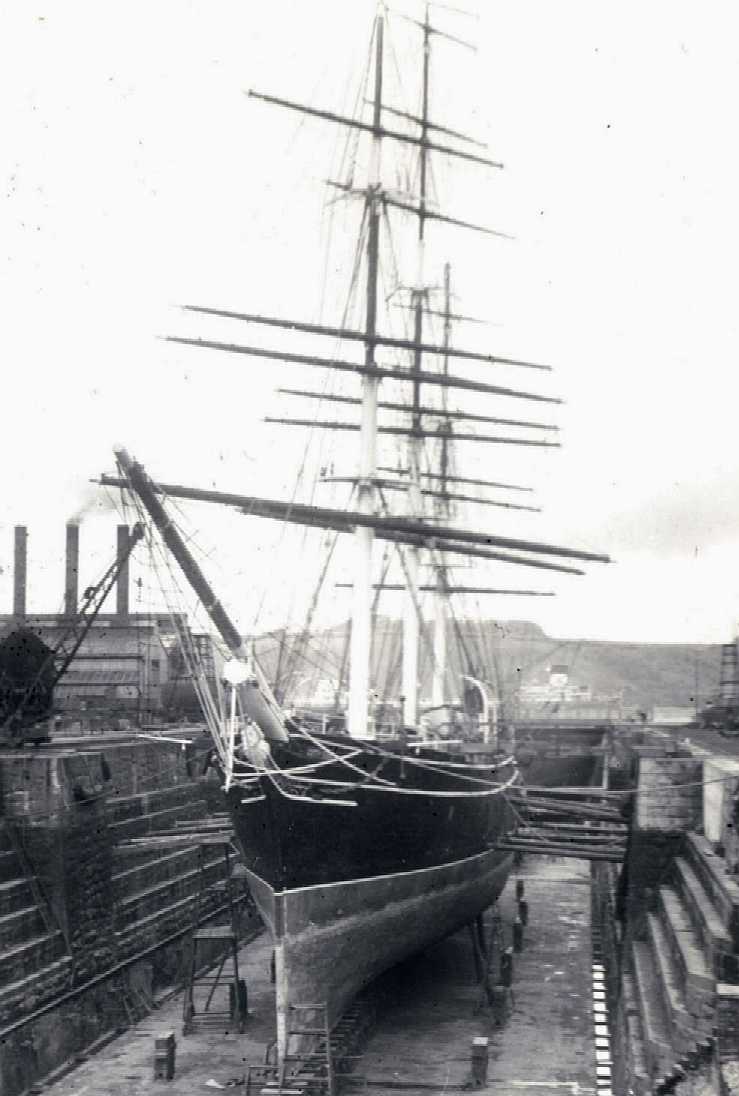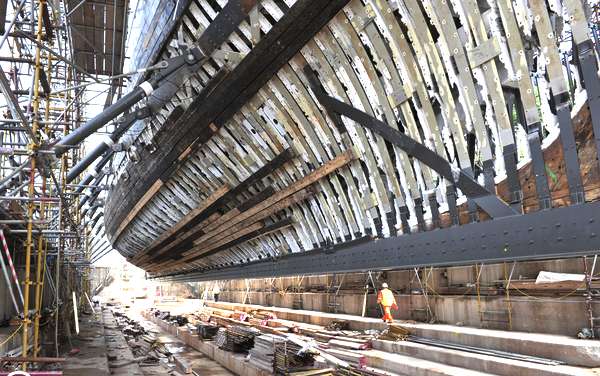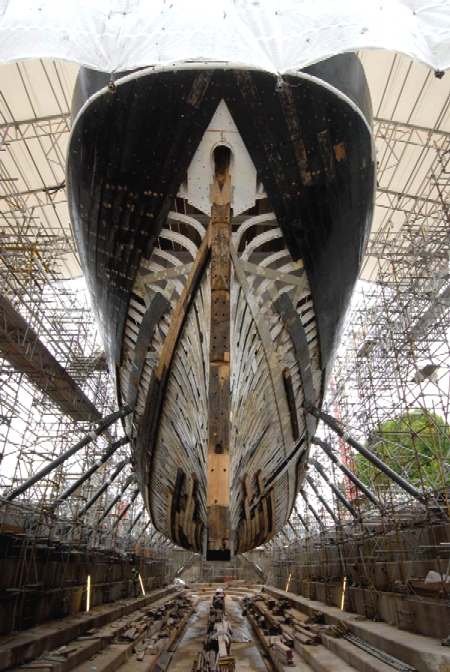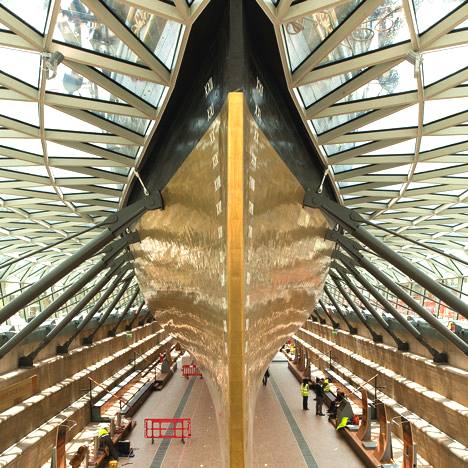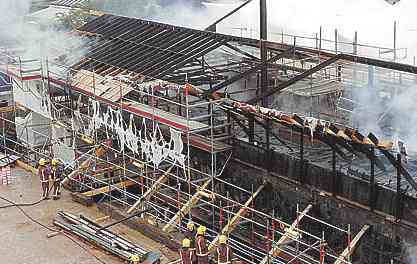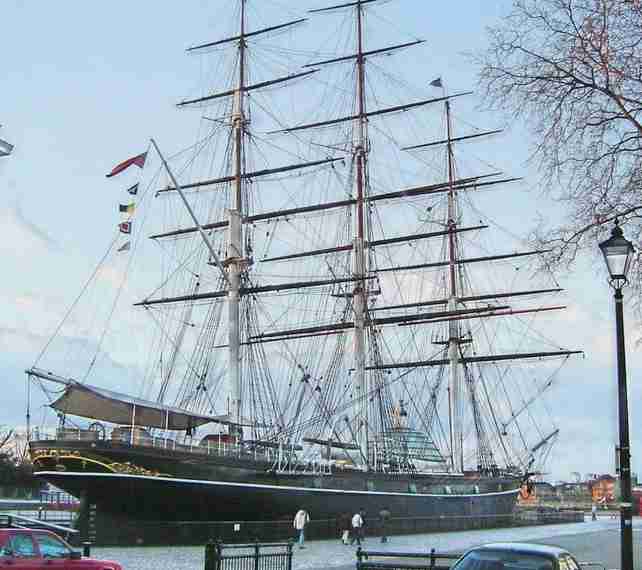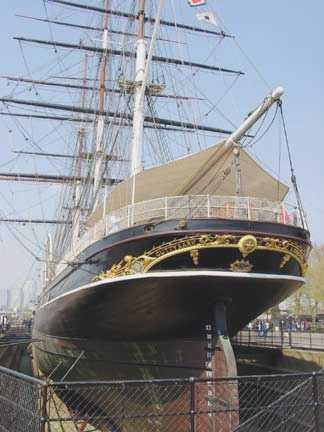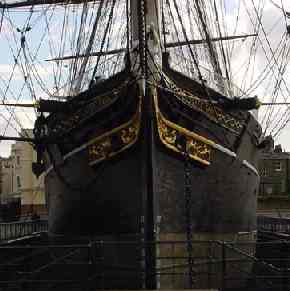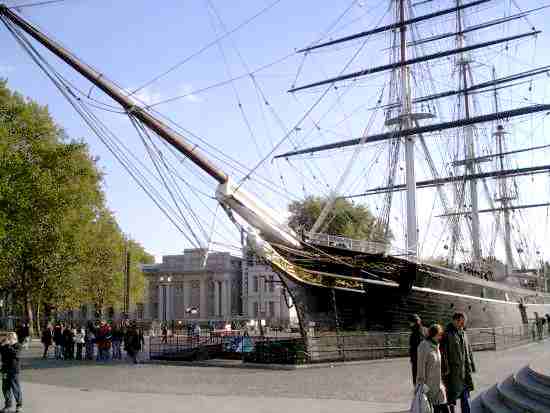|
CUTTY SARK
|
|||
|
HOME | BIOLOGY | FILMS | GEOGRAPHY | HISTORY | INDEX | INVESTORS | MUSIC | SOLAR BOATS | SPORT |
|||
|
The Cutty Sark's hull was seriously fire damaged in May 2007, but is now fully restored and a superb museum attraction thanks to some serious fund raising.
Monday, 21 May 2007
Blaze ravages historic Cutty Sark
I visited this amazing ship in the summer of 2005, as part of a river cruise and museum tour with my girlfriend. It is sad to think that while undergoing much needed restoration works this tragedy occurred. Two hours after a fire ripped through the hull of the Cutty Sark, the smell of burning timber lingered on the morning air as fire crews continued to soak the boat's decks and hull using pressure hoses.
The blaze was brought under control quickly.
Emergency
services received a call at 0446 BST from a member of the public who said
the Cutty Sark was ablaze.
The
138-year-old tea clipper lies just yards from the Thames in the heart of
Maritime Greenwich, a World Heritage Site. Beside it is the Royal Naval
College, Sir Christopher Wren's great baroque masterpiece of English
architecture.
The
fire is a major blow to a £25m renovation project to save the ship, which
has been under way since November 2006.
'Extremely
sad'
The project to transform the interior and setting of the ship was about a quarter of the way in and thankfully 50% of the ship's planks, the mast, deck houses and captain's cabin had been removed to storage in south-east London.
The fire swept through the entire remaining hull of the ship, which had been covered by a temporary roof, and the skeleton has suffered substantial damage.
"The boat was built for the China tea service - to be able to smell the burning timber and rope is extremely sad," Richard Doughty, project director and chief executive of the Cutty Sark Trust, told the BBC News website.
"The tragedy is you can't remake the fabric of the boat - these are timbers that were growing during the Battle of Agincourt [in 1415]. History itself has been lost." The boat has three decks and it appears two have suffered substantial damage. "It's a setback on many levels," said Mr Doughty.
The
renovation project was to have been completed in the summer of 2008. It
had received £13m from the Heritage Lottery foundation and almost £6m
from corporate and private donations, but there was still a £7m gap to
close, according to Mr Doughty.
He
said one of the first things that needed to be done was to assess how much
of the wrought iron skeleton had been damaged. "The principal
significance of the ship is its shape," he said. "This is formed
by the iron frames. If they have been seriously damaged, it's going to be
very hard to conserve the ship in the way we had planned."
"I have been planning this for six years - it was the next chapter in the history of the most famous ship in the world. The renovation programme has been shot to pieces." Mr Doughty described the ship as the epitome of speed under sail.
The Cutty Sark's fire crews tending hull 21 May 2007
'Needed
money'
Christ
Livett, chairman of the Cutty Sark Enterprises, which was carrying out the
restoration work, said the damage did not appear to be as bad as they
first thought.
He
told the media it was lucky so much of the ship had been removed. "It
is salvageable," he said. "The ship has been through many
things. We are devastated, lots of people worked hard on the
project."
Mr
Livett added the blaze had made them more determined to complete the
project to restore the much-loved clipper to her former glory and appealed
to the public to help pay for the damage.
"The Cutty Sark has always needed money since the day she was built - even more so today," he added. "The old girl needs more help than ever she did do in the past."
Renovation project manager Joseph James, of management consultant Hornagold & Hills, also told the BBC News website the ship's timbers would be salvageable.
Cutty Sark - refit in dry dock. A Scottish whisky is named after this ship
A fire which swept through the famous 19th Century ship Cutty Sark may have been started deliberately, police say.
The vessel, which was undergoing a £25m restoration, is kept in a dry dock at Greenwich in south-east London. Police are analysing CCTV images which are thought to show people in the area shortly before the fire started.
A
Cutty Sark Trust spokesman said much of the ship had been removed for
restoration and the damage could have been worse. Half the planking and
the masts had been taken away as part of the project.
Chris Livett, chairman of Cutty Sark Enterprises which is repairing the clipper, said at the scene: "From where I stand there is not a huge amount of damage to the planking that was left on. "There are pockets of charred planking and some have gone, but it doesn't look as bad as first envisaged."
The chief executive of the charitable Cutty Sark Trust, Richard Doughty, said: "What is special about Cutty Sark is the timbers, the iron frames that went to the South China Seas, and to think that that is threatened in any way is unbelievable, it's an unimaginable shock."
Following
an inspection of the site on Monday afternoon, Mr Doughty said:
"Buckling of the hull remains a big fear but until we do the
measurements we are not going to know. "With my naked eye, as far as
I have been able to see, the structure of the ship seems to be
intact." Insp
Bruce Middlemiss said detectives were looking into the possibility that
the fire had been started deliberately.
Special history
Firefighters were called to the scene at 0445 BST and the flames were put out by 0700 BST.
An area around the 138-year-old tea clipper had to be evacuated during the blaze. "The cause of the fire is now under investigation by London Fire Brigade and the Metropolitan Police," a London Fire Brigade spokesman said.
A number of witnesses have already come forward and the police are urging anyone else who may have been in the area to contact them. A silver car was seen leaving the scene but police said there is nothing at this stage to link it to the fire.
Greenwich Council leader councillor Chris Roberts said: "This is a devastating blow for what is a truly iconic symbol of Greenwich across the world. "The Cutty Sark has a unique and special history, which helps to draw millions of visitors to Greenwich every year."
The Cutty Sark left London on her maiden voyage on 16 February 1870, sailing around The Cape of Good Hope to Shanghai in three-and-a-half months. She made eight journeys to China as part of the tea trade until steam ships replaced sail on the high seas.
The ship was later used for training naval cadets during World War II, and in 1951 was moored in London for the Festival of Britain. Shortly afterwards, she was acquired by the Cutty Sark Society.
The ship was undergoing conservation work because sea salt had accelerated the corrosion of her iron framework. Dr Eric Kentley, curatorial consultant to the Cutty Sark Trust, said of the ship: "It can be saved. It's certainly not completely devastated.
"We will put her back together - but it's going to take much, much longer and a lot more money than we originally thought."
Visit London's chief executive James Bidwell said: "The ship's need for vital conservation has put it in the public eye recently and we can only hope that this terrible fire will redouble all our efforts to preserve this wonderful part of London's heritage."
The
Duke
of Edinburgh is due to visit the Cutty Sark on Tuesday. Culture
Secretary Tessa Jowell inspected the remains on Monday afternoon. The
Cutty Sark Trust is appealing for funds to help repair the fire damage and
complete the restoration.
HISTORY
Ships like the Cutty Sark were built to cross the Atlantic and Pacific Oceans at great speed. But she was overtaken by the advent of steam and the opening of the Panama Canal. Its final voyage was in 1938. The Cutty Sark is now a permanent exhibition at Greenwich, London, where a trust has been set up to restore her at an estimated £10M.
On the afternoon of Monday, 22nd November, 1869, a beautiful little clipper ship displacing 963 tons was launched from Scott and Linton's shipyard at Dumbarton, on the Clyde. She bcarried a name that was to become famous throughout the world and was destined to win a place in the hearts of British seamen second only to Nelson's immortal Victory. Her name was the Cutty Sark.
The Cutty Sark was designed by Hercules Linton as a composite built extreme clipper ship for "Old White Hat" Jock Willis of London. She sailed on the China Tea Trade for a couple of seasons without distinguishing herself and lost her rudder in 1872 off the Cape of Good Hope when racing Thermopylae for London with the first tea.
She was moved over to the Australian wool trade when the tea trade was taken over by the steam ships. Here she proved to be a regularly fast sailer. But was sold to the Portuguese in 1895 and served for many year's as the training ship Fereirra. Rerigged as a barquentine after having been dismasted in a gale off the Cape of Good Hope in May 1916 and renamed Mario do Ambaro.
Then in 1922 she was purchased by Capt. Dowman and restored for use as a stationary training ship, first at Falmouth then later in 1938 she was moved to The Thames where she remained until 1949 after which she was permanently dry-docked at Greenwich as a museum ship.
Her registered measurements were as follows: - gross
tons - 963, Built in 1869 at Dumbarton on the River Clyde Designed by Hercules Linton First voyage February 1870 Main mast stood 152ft (46.3m) above the deck
The Cutty Sark in her glass showcase
The Thermopylae was built at the shipyard of Walter Hood & Co., Aberdeen, in 1868 for George Thompson's "White Star Line". She measured 212.0 ft x 36.0 ft x 20.9 ft and 948 tons net. Designed as an extreme clipper for the China tea trade and rigged as a three-masted ship. On her maiden voyage Thermopylae made a record crossing from Gravesend to Melbourne in 63 days, on her continued voyage to Shanghai she set another record between those two ports.
In 1872 Thermopylae left Shanghai with a cargo of tea for London in company with the London clipper Cutty Sark. After racing each other for two weeks Cutty Sark lost her rudder after having passed the Sunda Straits. Thermopylae finally arrived in London only seven days ahead of her rival.
Sold to Canadian owners in 1890 who cut her down her rig to that of a barque. In 1895 Thermopylae was also sold to the Portuguese Government who converted her to a training ship and renamed her Pedro Nunes. Her end came in 1906 when she was torpedoed at sea by units of the Portuguese Navy.
Building
The Clyde-built Cutty Sark was, in 1869, one of the last sailing clippers to be built. She is preserved in dry dock at Greenwich in London, but was damaged in a fire on 21 May 2007 while undergoing extensive restoration.
Cutty Sark emergency fire services crew survey damage
The ship is named after the fictional character "Cutty-sark" (Scots: a short chemise or undergarment), an erotic dancing witch in Robert Burns' 1791 comic poem Tam o' Shanter. She was designed by Hercules Linton and built in 1869 at Dumbarton, Scotland, by the firm of Scott & Linton, for Captain John "Jock" "White Hat" Willis, and launched November 23 of that year.
The Cutty Sark was destined for the tea trade, then an intensely competitive race across the globe from China to London, with immense profits to the ship to arrive with the first tea of the year. However, she did not distinguish herself; in the most famous race, against Thermopylae in 1872, both ships left Shanghai together on June 18, but two weeks later Cutty Sark lost her rudder after passing through the Sunda Strait, and arrived in London on October 18, a week after Thermopylae, a total passage of 122 days. Her legendary reputation is supported by the fact that her captain chose to continue this race with an improvised rudder instead of putting into port for a replacement, yet was only beaten by one week.
In the end, clippers lost out to steamships, which could pass through the recently-opened Suez Canal and deliver goods more reliably, if not quite so quickly, which as it turned out was better for business. Cutty Sark was then used on the Australian wool trade. Under the respected Captain Richard Woodget, she did very well, posting Australia-to-Britain times of as little as 67 days. Her best run, 360 nautical miles (666 km) in 24 hours (an average 15kt, 27.75 km/h), was said to have been the fastest of any ship of her size.
In 1895 Willis sold her to the Portuguese firm Ferreira and she was renamed Ferreira after the firm, although her crews referred to her as Pequena Camisola ("little shirt", a straight translation of the Scots "cutty sark"). In 1916 she was dismasted off the Cape of Good Hope, sold, re-rigged in Cape Town as a barquentine, and renamed Maria do Amparo. In 1922 she was bought by Captain Wilfred Dowman, who restored her to her original appearance and used her as a stationary training ship. In 1954 she was dry-docked at Greenwich.
Cutty Sark is also preserved in literature in Hart Crane's long poem "The Bridge" which was published in 1930.
Cutty Sark, January 2005
Today
The Cutty Sark is today preserved as a museum ship and popular tourist attraction. She is located near the centre of Greenwich, in south-east London, close aboard the National Maritime Museum, the former Greenwich Hospital, and Greenwich Park. She is also a prominent landmark on the route of the London Marathon. She flies signal flags on her ensign staff reading "JKWS", which is the code representing Cutty Sark in the International Code of Signals, introduced in 1857.
Cutty Sark inspired the name of a brand of whisky. An image of the ship appears on the label, and the maker formerly sponsored the Cutty Sark Tall Ships' Race. She also inspired the name of the Saunders Roe Cutty Sark flying boat. The Life and Times of Scrooge McDuck part three-and-a-half: The Cowboy Captain of the Cutty Sark by Don Rosa features the ship herself. In the award winning science fiction novel Blue Mars, by Kim Stanley Robinson, the Cutty Sark is portrayed sailing on the oceans of a post global warming earth.
Cutty Sark is a Grade I listed monument and is on the Buildings At Risk Register.
Cutty Sark station on the Docklands Light Railway is one minute's walk away, with connections to central London and the London Underground. Greenwich Pier is next to the ship, and is served by scheduled river boats from piers in central London. A tourist information office stands to the east of the ship.
Conservation and fire
On 21 May 2007 the Cutty Sark, which had been closed and partly dismantled for conservation work, caught fire.
The ship was reported by the BBC to be completely ablaze. The extent of the damage is not yet known but there is concern that it may have affected the framework of the ship. The fire was reported to the fire service at 4:46 a.m. British Summer Time by members of the public. A representative of London Fire Brigade said at 7:09 a.m. that the fire was well under control and that damage was extensive but until the experts could make a full damage assessment survey, it was unknown just how much has been lost. The fire was declared by a journalist on site to have been out at 07:21 a.m., with most of the wooden structure in the centre having been lost.
Cutty Sark, stern and rudder
In an interview with the chief executive of the Cutty Sark Trust it was revealed that at least half of the "fabric" (timbers, etc) of the ship is not on the site as it is being dismantled for the preservation work, and that they are most worried about the iron framework to which the fabric is attached.
Aerial video footage at 7:22 a.m. showed extensive damage but seems to indicate that the ship has not been destroyed in its entirety. A fire officer present at the scene said in a BBC interview that when they arrived, there was "a well-developed fire throughout the ship". The bow section looks to be relatively unscathed and the stern also appears to have survived without major damage. The fire seems to have been concentrated in the centre of the ship.
The Chairman of Cutty Sark Enterprises who has inspected the site said at around 8:35 a.m., "The decks are unsalvageable but around 50% of the planking had already been removed; however, the damage is not as bad as originally expected." It has already been stated that the ship can be restored, the damage being less than originally thought. Up to half of the original material is currently being stored off-site during restoration. The chief executive of the Cutty Sark Trust did not know how much extra the ship would cost to restore, but estimated it at an extra £5-10 million, bringing the total cost of the ship's restoration to £30-35 million.
It has also been officially stated that, once restored, the ship will still predominantly be the original Cutty Sark although it is obvious that material lost in the blaze will have to be re-created. The bow was predominantly undamaged, the stern appears fairly intact, and the rest, whilst damaged, should at least be in part repairable. As such the ship will still have a majority of the original parts and will still be the "Cutty Sark".[citation needed] (The question of whether or not the ship is the same ship after repair is is an example of the ancient Ship of Theseus paradox).
The cause of the fire is currently unknown but is being treated as "suspicious" by the authorities.
As part of the restoration work planned before the fire, the ship was proposed to be raised three metres out of her dry dock, to allow the construction of a state of the art museum space beneath. This would allow visitors will be able to admire her sleek shape from below.
The Cutty Sark at Greenwich, London
MARITIME HISTORY
GENERAL HISTORY
The Cutty Sark with the Greenwich maritime museum in background
LINKS and REFERENCE
A taste for adventure
One whale can make a difference
|
|||
|
This
website
is Copyright © 1999 & 2015. The bird |
|||
|
AUTOMOTIVE | BLUEBIRD | ELECTRIC CARS | ELECTRIC CYCLES | SOLAR CARS |
